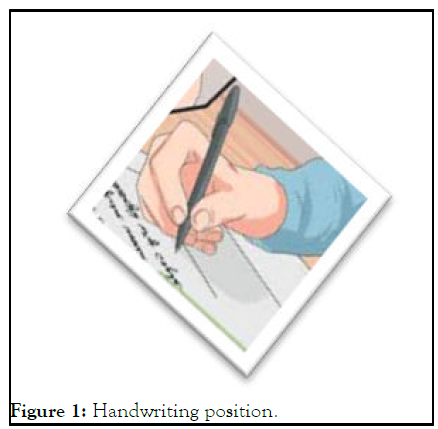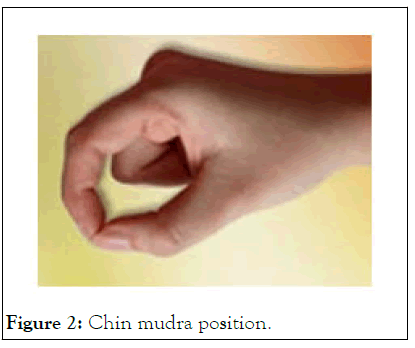Journal of Yoga & Physical Therapy
Open Access
ISSN: 2157-7595
ISSN: 2157-7595
Short Communication - (2023)Volume 13, Issue 1
Recent health surveys depict that there are several reasons why writing by hand is a better option for improving brain power. In today’s technology dependent world of smart phones and laptops, it is not surprising that mostly all are more comfortable using keyboard than a pen [1]. This article reveals that writing by hand improves memory or overall brain power by means of writing posture that imitates chin mudra or mudra of knlowledge.
Handwriting plays a vital role in brain development and sets the foundation for other skills and abilities such as writing, language usage, reading, thinking out of the box or cognitive abilities, reasoning skills and communication skills [2]. The practical writing posture as in the following Figures 1 and 2 uses thumb finger and index finger along with writing material. The tips of thumb and index finger are closed by the writing material which looks like chin mudra one of yoga mudra as shown in the following Figures 1 and 2.

Figure 1: Handwriting position.

Figure 2: Chin mudra position.
Benefits of writing by hand
Increased cognitive ability: Writing by hand is an art to improve cognitive skills of humans. Writing by hand requires a combination of visual, motor and cognitive skills which is an integral part of the learning.
Increased focus or concentration: Hand writing stimulates certain part of brain called Reticular Activating System (RAS) which is responsible for sensory information and differentiating good or bad. So writing by hand also helps to focus on the given task and minimal scope of distraction.
Improved memory: Hand writing information leads to better factual learning and conceptual learning process [3]. It is also a primer method of memorizing. Hand writing information helps to improve memory in both young students and also aged individuals that sharpens their mental expertise as well as improve their memory.
Introduction to chin mudra: Mudras meaning ‘seal’, ‘mark’, or ‘gesture’ in Sanskrit are said to intensify the effects of our yoga or meditation practice and enhance the flow of energy. Chin mudra is the gesture of consciousness [4]. The thumb and index fingers touch lightly together, as above in the figure. This more introspective gesture is said to have a grounding effect, encouraging our attention and focus to move inwards.
Hand writing take advantage of chin mudra: From the series of experiments conducted by psychological and physiological scientists of various universities, and they were divided students into two groups where one group used laptops to take notes while the others used traditional notebooks. The experiments proved that the students who took notes using laptops were more likely to take verbatim notes with little or no mental processing of the information [5]. Students who used notebooks memorized the information better and were able to understand and retain the knowledge better. This result shows that writing by hand is a valuable and improves memory power of peoples for all ages.
Hand writing gives more attention and knowledge to the writer because, writing indirectly lets index finger and thumb finger to be touched with writing material and turn writing material stops the flow of energy passing away from index and thumb finger and redirects to the brain cells. This energy redirection motivates brain cells to think or concentrate and memorize fast. This writing posture portrays chin mudra (knowledge mudra) of yoga concept. Hence handwriting improves knowledge and efficiency of human brain because it reflects or imitates chin mudra.
[Crossref] [Google Scholar] [PubMed]
[Crossref] [Google Scholar] [PubMed]
Citation: Karthik N (2023) Handwriting Reflects Chin Mudra for Improved Knowledge and Efficiency of Human Brain. J Yoga Phys Ther. 13:384.
Received: 01-Mar-2023, Manuscript No. JYPT-19-2756; Editor assigned: 03-Mar-2023, Pre QC No. JYPT-19-2756(PQ); Reviewed: 17-Mar-2023, QC No. JYPT-19-2756; Revised: 24-Mar-2023, Manuscript No. JYPT-19-2756(R); Published: 31-Mar-2023 , DOI: 10.35248/2157-7595.23.13.379.
Copyright: © 2023 Karthik N. This is an open-access article distributed under the terms of the Creative Commons Attribution License, which permits unrestricted use, distribution, and reproduction in any medium, provided the original author and source are credited.